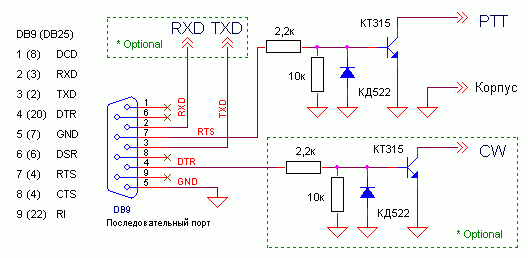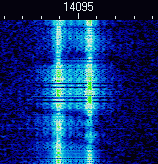Digital types of communication with radio amateurs
With the development of computer technology, all areas of our lives have undergone changes, amateur radio is no exception.
Previously, in order to conduct a QSO "figure" it was necessary to design various types of SSTV monitors, etc.
Now for digital types of communications you only need a transceiver and a computer with a sound card, more about this under the cut.
Only registered amateur radio operators have the right to work (radiate) on amateur radio bands!
It is possible to receive signals (to be an observer) without registration, but if you are interested in observation reports (QSL cards) then you need to get the observer's call sign).
Any transceiver is suitable for us (even VHF, only you need to take into account the communication range on this range) with SSB modulation, if it has VOX (activation of voice transmission), then our task is a little simplified, but everything is in order.
Any computer with a sound card will do (we need a speaker output + line or microphone input).
Any OS will do.
If the transceiver has a VOX , two audio cables are enough for us, one connects the low-frequency output of the transceiver to the line input of the computer, the other low-frequency output of the computer with the microphone input of the transceiver.
To prevent high-frequency signals from affecting the operation of the computer, it is better to galvanically decouple the sound connections with transformers (suitable from dialup modems).
If there is no VOX in the transceiver , you need to add a simple circuit from the COM port to the above:

For reference: PTT Push to Talk, in other words, the transmit button on the tangent or the “pedal” of the transceiver.
If you want to automatically transmit the morse code, you can do the CW output (it connects to the transceiver key input).
There are a lot of programs under the vendor, I will talk about one of them:
I use UR5EQF_log , it is free, it supports many types of communications and it has a good hardware logbook, which is also suitable for recording regular communications.
Official screen:

From the paid software is good MIXW (20USD, free for children kollektivok)
For Linux, programs are slightly inferior, but you can use them.
There is even a specially sharpened distr for radio destroyers - Shackbox .
There are a lot of types of work with the numberover 9000 , I will give two main ones:
It is the first of the digital types of communication used by radio amateurs, and it is a direct-printing radio telegraph (radio teletype).
At the waterfall it looks like this:

Phase Shift Keying
The main plus, the signal emitted by the transmitter, takes on the air band only 31 Hz! This allows the use of narrow-band filters on the receiving side. Accordingly, the signal-to-noise ratio improves much better - an eternal problem on radio routes.
PSK is still divided into different text transmission rates (PSK-31, PSK-63, PSK-125) but the main one is BPSK-31
Screen from the “waterfall” (three signals are displayed):

You can hear and work on digital types of communication:
RTTY - On a range of 20 m (14 MHz) in the area between 14070 and 14100 kHz (“calling” frequency 14080 kHz. Often a teletype is heard, depending on the conditions of passage, at ranges from 40 to 10 m.
BPSK-31 - Most PSK stations operate in the frequency region of 14070 kHz (as well as 7040, 21070, 28080 and 28020 kHz)
To end my story, I will be a profit for all this business (except moral satisfaction), these are diplomas for digital forms of communication.
Most diplomas can be obtained through the EPC system.
The European PSK Club or EPC is an informal club of amateur radio operators, organized on June 10, 2006 in order to maintain a high level of amateur radio communications in digital forms of PSK.
Making connections, they are recorded in your hardware journal, by sending which the EPC will check you for passing the conditions of many, many diplomas from different countries. The only negative (or maybe plus) diplomas you will receive in electronic form. Then you can go to the "photo center" (or as it is now called) and print yourself a beautiful diploma.
Here is some of them:


PS To write the article the following was used:
- Fundamentals of amateur radio communication A.N. Zamoraka (RA0CL. Ex UA0CJQ)
- ur5eqf.com
- www.mixw.net
Previously, in order to conduct a QSO "figure" it was necessary to design various types of SSTV monitors, etc.
Now for digital types of communications you only need a transceiver and a computer with a sound card, more about this under the cut.
Disclaimer
Only registered amateur radio operators have the right to work (radiate) on amateur radio bands!
It is possible to receive signals (to be an observer) without registration, but if you are interested in observation reports (QSL cards) then you need to get the observer's call sign).
For "numbers" it is necessary
Transceiver
Any transceiver is suitable for us (even VHF, only you need to take into account the communication range on this range) with SSB modulation, if it has VOX (activation of voice transmission), then our task is a little simplified, but everything is in order.
A computer
Any computer with a sound card will do (we need a speaker output + line or microphone input).
Any OS will do.
Communication with the transceiver
If the transceiver has a VOX , two audio cables are enough for us, one connects the low-frequency output of the transceiver to the line input of the computer, the other low-frequency output of the computer with the microphone input of the transceiver.
To prevent high-frequency signals from affecting the operation of the computer, it is better to galvanically decouple the sound connections with transformers (suitable from dialup modems).
If there is no VOX in the transceiver , you need to add a simple circuit from the COM port to the above:

For reference: PTT Push to Talk, in other words, the transmit button on the tangent or the “pedal” of the transceiver.
If you want to automatically transmit the morse code, you can do the CW output (it connects to the transceiver key input).
Software
Windows
There are a lot of programs under the vendor, I will talk about one of them:
I use UR5EQF_log , it is free, it supports many types of communications and it has a good hardware logbook, which is also suitable for recording regular communications.
Official screen:

From the paid software is good MIXW (20USD, free for children kollektivok)
Linux
For Linux, programs are slightly inferior, but you can use them.
There is even a specially sharpened distr for radio destroyers - Shackbox .
Types of Digital Communications
There are a lot of types of work with the number
RTTY
It is the first of the digital types of communication used by radio amateurs, and it is a direct-printing radio telegraph (radio teletype).
At the waterfall it looks like this:

PSK-31
Phase Shift Keying
The main plus, the signal emitted by the transmitter, takes on the air band only 31 Hz! This allows the use of narrow-band filters on the receiving side. Accordingly, the signal-to-noise ratio improves much better - an eternal problem on radio routes.
PSK is still divided into different text transmission rates (PSK-31, PSK-63, PSK-125) but the main one is BPSK-31
Screen from the “waterfall” (three signals are displayed):

Where do the numbers work:
You can hear and work on digital types of communication:
RTTY - On a range of 20 m (14 MHz) in the area between 14070 and 14100 kHz (“calling” frequency 14080 kHz. Often a teletype is heard, depending on the conditions of passage, at ranges from 40 to 10 m.
BPSK-31 - Most PSK stations operate in the frequency region of 14070 kHz (as well as 7040, 21070, 28080 and 28020 kHz)
Diplomas
To end my story, I will be a profit for all this business (except moral satisfaction), these are diplomas for digital forms of communication.
Most diplomas can be obtained through the EPC system.
The European PSK Club or EPC is an informal club of amateur radio operators, organized on June 10, 2006 in order to maintain a high level of amateur radio communications in digital forms of PSK.
Making connections, they are recorded in your hardware journal, by sending which the EPC will check you for passing the conditions of many, many diplomas from different countries. The only negative (or maybe plus) diplomas you will receive in electronic form. Then you can go to the "photo center" (or as it is now called) and print yourself a beautiful diploma.
Here is some of them:


PS To write the article the following was used:
- Fundamentals of amateur radio communication A.N. Zamoraka (RA0CL. Ex UA0CJQ)
- ur5eqf.com
- www.mixw.net
